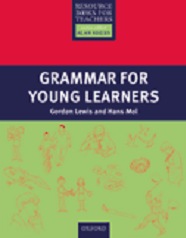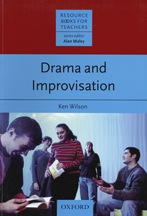Short Book Reviews
Hanna Kryszewska, Poland
Hanna Kryszewska is a teacher, teacher trainer, trainer of trainers. She is a senior lecturer at the University of Gdańsk, and EU Teacher Training College where she trains pre-service teachers. She is also Director of Studies at SWPS, Sopot, Poland. She is co-author of resource books: Learner Based Teaching, OUP, Towards Teaching, Heinemann, The Standby Book, CUP, Language Activities for Teenagers, CUP and a course book series for secondary schools: ForMat, Macmillan. She is also co-author of a video based teacher training course: Observing English Lessons. Hania is a Pilgrims trainer and editor of HLT Magazine.
E-mail: hania.kryszewska@pilgrims.co.uk

Grammar for Young Learners. G. Lewis and H. Mol. (2009) Oxford University Press. ISBN 978-0-19-442589-6, pp152. The book is part of the well known and appreciated series: “Primary Resource Books for Teachers”. The book offers some background to teaching grammar to young learners and their preferred learning styles but its real strength is its wealth of activities. There are around 100 activities which practice specific grammar structures. The grammar content is well disguised and children practice grammar by playing games, singing, drawing or working with the photocopiable sheets to be found at the end of the book. The approach is stress free as the young learners are first presented the structure, exposed to a model, or are reminded of the structure and then are expected to produce language containing the structure. The books contains 20 sections each devoted to a grammar point or structure. Sometimes the grouping is a bit ‘forced’ and, for example, an activity aiming at practising the verb ‘to be’ also requires the use of other, more complex, grammar structures (1.2), while some other exercises focus only on the given structure ( 1.3, 6.40). This is definitely a ‘dip in’ book and don’t expect that you will be able to use all the activities with your class as the level of difficulty of the activities goes up to intermediate( 8.2) or even above (10.3), some require the use of metalanguage (section 19) and some use difficult language like ‘a suspect’, ‘chores’. (But it all boils down to how we understand the term ‘young learner’). Teachers who are into the Theory of Multiple Intelligences will like the fact that for each activity the authors identify which intelligence or intelligences are activated in the exercise.

Drama and Improvisation. K. Wilson (2008) Oxford University Press. ISBN 978-0-19-442580-3, pp 125. The book is rooted in the work of the Comedy Store Players and the work of Viola Spolin. The author not only acknowledges their influence on his work but pays a true tribute to them. The author himself has had an impact on the ELT drama world, through his involvement in the English Teaching Theatre. In the foreword to the book Alan Maley, the series editor, puts in a nutshell the reasons why we should use drama in class. Drama offers: “playfulness”, “enjoyment”, “physical movement”, “affective engagement”, “effortless effort” and “unpredictability”. The book offers activities which have all these features at their core. They are grouped in five chapters which focus on icebreakers and gelling, interaction and improvisation, games, drama club, working with text and transcript. I cannot quite see why there is a special section devoted to organising and running a drama club. The activities contained there seem to belong to other chapters of the book. On the whole the book is a good balance of classic drama activities and innovative ideas which will surely become classic. The book is very inspiring and refreshing. A must have.

Uncovering CLIL. Content and Language Integrated Learning in Bilingual and Multilingual Education. P. Mehisto, D. Marsh and M.J. Frigols. (2008) Macmillan. ISBN 978-0-230-02719-0, pp 238. This book has been published in the Macmillan Books for Teachers series, edited by Adrian Underhill. The book responds to the needs of a growing number of teachers who have to combine language content and content derived from other subjects. The book starts with a very informative and well written introduction to CLIL and its many facets. It is a pity the authors do not relate their terminology to that adopted by the Council of Europe, i.e. CULTIX, ENTIX, LANTIX, CONTIX, LEARNTIX. The book is well structured and takes the readers gradually from getting ready for CLIL, through implementing CLIL to enriching CLIL and looking for new tools and teaching programmes, including portfolio and blended learning. The issues introduced in each chapter are illustrated by lesson plans. The topics include: wetlands, age, health and safety at work to name just a few. The topics and language levels make the book suitable for teachers of more adult learners whose language level is at least intermediate. If you teach lower levels and/or younger learners you will need to turn to other publications for practical examples. The book does not contain photocopiable pages, and even if you decided to copy some of the texts they cannot be used as they come with teacher’s notes. I am sure though you will be able to find similar texts from other sources. If you are a visual person you may thoroughly dislike some of the illustrations, e.g. p. 25, p. 172, p.214. Overall the book is good value for money, maps out how to gradually introduce CLIL in teaching young adults and will be suitable in bilingual and multilingual education. Also teachers in IB classes would greatly benefit from this publication.

Please check the Methodology and Language for Primary Teachers course at Pilgrims website.
Please check the Drama course at Pilgrims website.
Please check the CLIL - Teaching Other Subject Through English course at Pilgrims website.


|